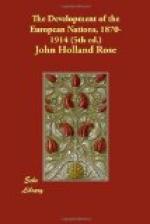The period since the year 1870 has for the most part witnessed the operation of the last and the least romantic of these so-called civilising efforts. The great age of African exploration was then drawing to a close. In the year 1870 that devoted missionary explorer, David Livingstone, was lost to sight for many months owing to his earnest longing peacefully to solve the great problem of the waterways of Central Africa, and thus open up an easy path for the suppression of the slave-trade. But when, in 1871, Mr. H.M. Stanley, the enterprising correspondent of the New York Herald, at the head of a rescue expedition, met the grizzled, fever-stricken veteran near Ujiji and greeted him with the words—“Mr. Livingstone, I presume,” the age of mystery and picturesqueness vanished away.
A change in the spirit and methods of exploration naturally comes about when the efforts of single individuals give place to collective enterprise[424], and that change was now rapidly to come over the whole field of African exploration. The day of the Mungo Parks and Livingstones was passing away, and the day of associations and companies was at hand. In 1876, Leopold II., King of the Belgians, summoned to Brussels several of the leading explorers and geographers in order to confer on the best methods of opening up Africa. The specific results of this important Conference will be considered in the next chapter; but we may here note that, under the auspices of the “International Association for the Exploration and Civilisation of Africa” then founded, much pioneer work was carried out in districts remote from the River Congo. The vast continent also yielded up its secrets to travellers working their way in from the south and the north, so that in the late seventies the white races opened up to view vast and populous districts which imaginative chartographers in other ages had diversified with the Mountains of the Moon or with signs of the Zodiac and monstrosities of the animal creation.
[Footnote 424: In saying this I do not underrate the achievements of explorers like Stanley, Thomson, Cameron, Schweinfurth, Pogge, Nachtigall, Pinto, de Brazza, Johnston, Wissmann, Holub, Lugard, and others; but apart from the first two, none of them made discoveries that can be called epoch-marking.]
The last epoch-marking work carried through by an individual was accomplished by a Scottish explorer, whose achievements almost rivalled those of Livingstone. Joseph Thomson, a native of Dumfriesshire, succeeded in 1879 to the command of an exploring party which sought to open up the country around the lakes of Nyassa and Tanganyika. Four years later, on behalf of the Royal Geographical Society, he undertook to examine the country behind Mombasa which was little better known than when Vasco da Gama first touched there. In this journey Thomson discovered two snow-capped mountains, Kilimanjaro and Kenia, and made known the resources of the country as far inland as




